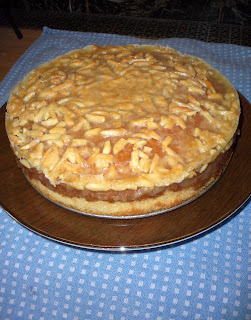 |
| Saint Lucy by Francisco de Zurbaran, oil on canvas, c. 1625/1630 from the Chester Dale Collection at the National Gallery of Art |
So,
I decided to add tributes to St. Lucy to our weekend festivities… starting with
Norwegian Caramel-Almond Tosca Cake for my boss’ holiday party. Swedish Saffron Buns (Lussekatter) or Saffron Bread
(Saffransbullar) are the more traditional Scandinavian treats for St. Lucy’s
Day. But this Tosca Cake is always a
crowd pleaser.
The
recipe comes from The Great Scandinavian Baking Book by Beatrice Ojakangas.
Cake:3 eggs
1 cup sugar
1 teaspoon vanilla
1½ cups all-purpose flour
1½ teaspoons baking powder
¾ cup butter, melted
3 tablespoons milk
Topping:
1/3 cup butter½ cup slivered blanched almonds
½ cup sugar
½ cup whipping cream
Beat the eggs until foamy. Add sugar and beat until light and lemon colored; add vanilla. Mix flour with baking powder and fold into the egg mixture until blended.
Mix the melted butter and milk and stir into the flour and egg mixture until batter is smooth and blended. Turn into a buttered 10” springform pan or an 11” or 12” tart pan with a removable bottom. Bake at 350 degrees for 35 minutes. Meanwhile, prepare the topping. Melt butter in a 8” or 9” frying pan. Add almonds, and stir over medium heat until almonds are toasted and golden. Stir in the sugar and cream. Turn heat to high and bring to a vigorous boil, stirring constantly.
Boil for 2½ minutes just until mixture begins to become slightly darker tan and thickens slightly. Pour hot topping over cake and place under broiler until topping is bubbly and lightly browned.
I follow the recipe as written and use a springform pan. Our medium frying pan bit the dust awhile ago, so I just use a saucepan to brown the almonds and boil the caramel. It works well, because there is sometimes a little splatter.
Here
are two tips:
Gather
your ingredients, but delay cooking the caramel until you have about 18-20
minutes left on the cake. You don’t want
it to harden or darken too much.Once you have broiled the topping, allow the cake to cool on a wire rack for 15-20 minutes. Then release the cake from the springform pan.
I know it sounds time-consuming to cook the cake three times: bake, boil and broil. But you can tackle it all in about an hour.
No
one has adequately explained to me why this cake has an operatic name,
especially from such a violent opera. But
the sponge cake and crispy almond topping definitely seem like northern
renditions of classic Italian flavors (with the addition of lots and lots of
butter). I’ve made the cake for
birthdays and showers, but perhaps it is best suited for a celebration of Santa
Lucia – the young Italian saint, whose story has been adopted and adapted and revered
throughout Scandinavia, even now, more than a millennium after her death.








No comments:
Post a Comment
Note: Only a member of this blog may post a comment.